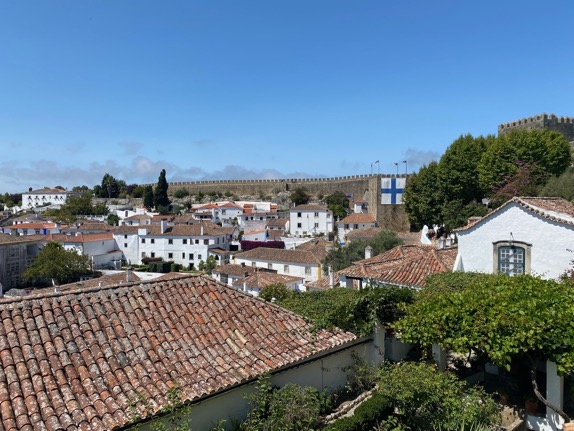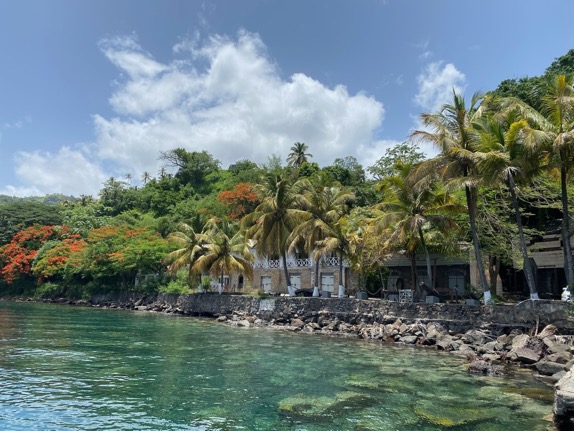Summer in Portugal After the Long Absence from the Country 🇺🇸🇵🇹🇪🇺

Obidos, Portugal, August 2021
In September 2021, after a long period of being unable to travel due to COVID-19 restrictions, I finally made my way back to Portugal. The excitement of boarding my flight to Lisbon in Newark was immense—I had been waiting for this moment for so long.
Portugal welcomed me with wonderful weather, which allowed me to travel extensively, revisiting familiar places and exploring new ones.
Óbidos – Home and Heart
As always, I spent time in Óbidos, a town that never loses its charm. Walking through its medieval streets, past whitewashed houses adorned with bougainvillaea, reminded me why I love this place so much.
One of the highlights of this visit was hosting my dear friend Maria and her husband Mahindra. Together, we explored Óbidos and Foz do Arelho, sharing great conversations and enjoying the relaxed pace of life.
Exploring the Silver Coast and Beyond
With so much time in Portugal, I took every opportunity to travel around:
• Lisbon – Always a vibrant and lively city, filled with history, tiled facades, and delicious food.
• São Martinho do Porto – A small seaside town with a beautiful natural bay, perfect for walks along the promenade.
• Foz do Arelho & Praia do Bom Sucesso – Stunning coastal areas near Óbidos, with golden beaches, strong Atlantic waves, and scenic golf courses. The Bom Sucesso Golf Course, nestled between the ocean and Lagoa de Óbidos, is one of the most picturesque in the region.
• Ferrel & Peniche – Famous for surf culture, where Karolina and her husband took surfing lessons, making the most of Portugal’s fantastic Atlantic waves.
• Alcobaça – Known for its impressive monastery, a UNESCO World Heritage site, and the tragic love story of Pedro and Inês.
• Nazaré – A town famous for its record-breaking waves, where surfers from around the world come to challenge the ocean.
• Caldas da Rainha – A town rich in thermal spa history and known for its lively markets and ceramic traditions.
• Figueira da Foz & Quiaios – I visited with Kasia and her boyfriend’s family, enjoying the mix of beach life and forested hills.
• Aveiro – Often called the Venice of Portugal, with its colourful moliceiro boats and charming canals.
• Montemor-o-Velho – A historic town with a magnificent castle overlooking the Mondego River, offering breathtaking views.
• Cascais & Ericeira – Two stunning coastal towns, each with their own character—Cascais for its elegance and marina, and Ericeira for its surf-friendly atmosphere.
A Visit from Brussels
Towards the end of my stay, I had another special visit—Karolina and her husband came from Brussels to spend time in Óbidos. We explored the town together and took a trip to Peniche, where they were thrilled to try surfing lessons—a must in this part of Portugal!
A Perfect Return to Portugal
This trip was exactly what I needed—beautiful places, great friends, and the joy of rediscovering a country I love. Whether wandering the medieval streets of Óbidos, admiring the wild Atlantic coastline, or sharing special moments with friends and family, every day felt like a gift.
Portugal had treated me well once again, and I left knowing I would always be back.
Click here to access the album.
Saint Vincent and the Grenadines: Disaster in the Paradise 🇻🇨

Peter's Hope, Saint Vincent and the Grenadines, August 2021
In April 2021, the La Soufrière Volcano erupted violently in Saint Vincent and the Grenadines (SVG), causing widespread destruction. Over 20,000 people—nearly one-sixth of the country’s total population—were forced to evacuate, with many fleeing to the southern part of Saint Vincent or to neighbouring Saint Lucia and Barbados.
While 20,000 evacuees may not seem staggering on a global scale, for a small nation like SVG (with a population of around 120,000), the impact was catastrophic. The eruption devastated homes, infrastructure, and livelihoods, all while the country was still grappling with the COVID-19 pandemic, making the humanitarian response even more complex.
The Immediate Challenges of the Humanitarian Response
The disaster struck at a difficult time. International aid efforts were complicated by pandemic-related travel restrictions, and the risks of crowded evacuation shelters raised fears of COVID-19 outbreaks. The response had to balance emergency relief with public health concerns, adding layers of difficulty to an already urgent crisis.
Despite these challenges, local and international agencies acted quickly, setting up evacuation centres, distributing food and hygiene kits, and providing medical and psychological support to those displaced. However, as the ash clouds settled and the immediate relief efforts transitioned into recovery, the long-term impacts became clearer—destroyed homes, lost livelihoods, and the difficult process of rebuilding in a small island state already vulnerable to natural disasters.
My Mission in SVG – Assessing Recovery Efforts
In August 2021, I travelled to Saint Vincent to meet with partners and humanitarian organisations, assessing how resources were being used and what more needed to be done.
At first, the mission felt challenging in an unexpected way. Many of the visible scars of the eruption had already been cleared—ash had been washed away, streets had been cleaned, and life seemed, at first glance, to be returning to normal. But as I spoke with officials, first responders, and survivors, I came to understand the deep, ongoing struggles beneath the surface—people without homes, farmers who had lost everything, and families still piecing their lives back together.
Despite the tragedy, I found the people of Saint Vincent incredibly warm and welcoming, and I took the time to explore different parts of the island, each offering a unique glimpse into the country’s beauty and resilience.
Exploring Saint Vincent – A Land of Beauty and Strength
While the northern parts of the island bore the brunt of the volcanic destruction, much of Saint Vincent’s natural beauty remained untouched, creating a striking contrast between paradise and disaster.
• Kingstown – The nation’s capital, filled with colonial-era buildings, colourful markets, and a vibrant energy, despite the hardships the country had faced.
• Arnos Vale – A lively suburb near Kingstown, home to bustling commercial areas and a historic cricket stadium, showing the everyday rhythm of life in SVG.
• Peter’s Hope & Coulls Hill – Areas where I saw firsthand the effects of the eruption, as many families were still displaced, struggling to rebuild.
• Saint Patrick – A rural region where the landscape had been transformed by volcanic ash, but where efforts were underway to restore agricultural production.
• Vermont Nature Trail & Rainforest – One of the island’s most breathtaking spots, filled with lush greenery, cascading waterfalls, and an incredible variety of birds, offering a peaceful contrast to the devastation elsewhere.
• Georgetown & Charlotte – Towns near the north of the island, where many residents had been forced to flee, and where the challenges of recovery were most visible.
• New Sandy Bay Village, Owia, and Fancy – These northernmost villages were among the hardest-hit areas, with many homes buried under volcanic ash and debris. Despite the destruction, I was struck by the resilience of the communities—people determined to rebuild and move forward.
A Nation Moving Forward
Saint Vincent and the Grenadines faced an overwhelming disaster, but in my time there, I saw a country determined to recover. While the landscape was as beautiful as ever, the true strength of SVG lay in its people—their resilience, their sense of community, and their ability to rebuild even after immense loss.
This mission was a reminder that disasters do not end when the immediate crisis is over. Recovery is a long and difficult process, requiring continued support, resources, and global solidarity.
As I left Saint Vincent, I carried with me a deep admiration for this small but strong island nation and the people working tirelessly to restore what was lost.
Click here to access the album.
